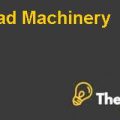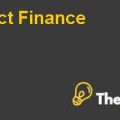
Financial Analysis
- 1. Prepare a financial analysis of Steria.
Steria had reported a good performance over the years and our analysis in Appendices 1 shows that the sales had increased by 19.5% in 2005 and a further increase by 7.4% in 2006, which tend the company to report an increase in net earnings by 56.5% in 2005 and 50% in 2006. Further, the merger with Mummertin in 2005 also benefited the organization to achieve economies of scale, which tend the company to report an increase in EBITDA margin from 6.1% in 2004 to 8.32% in 2006.
Moreover, the ROCE of the company has significantly been increased from 8.9% in 2004 to 13.1% in 2006, which indicates that the company succeeded to generate sufficient profits from its capital employed
- 2. Prepare a stock market analysis of Steria.
Low Yields and Payout Ratios
Yields and payout ratios are very much low and this is because Steria has high growth trends and Steria has been financing its investment need through internally generated funds, therefore, it retains more of its earning in order to finance its investing needs.
Price to Earnings (P/R) Ratio
Steria’s growth in later years confirms that it has high P/E ratio during the 2004; hence, its stock prices value fairly reflects the market value of Steria.
Return on Equity
Steria seems to be creating value for its shareholders because the return required by the shareholders is below than ROE. It can further be justified from the fact that the market capitalization is above than the book value of equity.
Stock Volatility
The share price is very much fluctuating and this volatility of share price represents the risk faced by investors and their low interest in shares.
High Beta Value
Beta value of 1.86 represents the higher risk to which Steria is exposed, moreover, the price to earnings ratio also shows a declining trend; whih could be partly due to higher unsystematic risk and partly due to potential decline in future growth opportunities.
- 3. Compute the control premium (in million euros) paid by Steria for purchasing 100% of Xansa.
Control premium is the excess amount paid by Steriain in order to obtain the control in the Xansa. The total purchase price of 100% equity in Xansa is €660 million including a market premium of 69.9% to market price. Our analysis in Appendices 2 shows that the market capitalization amounts a total of €388 million, which led the company to report a control premium of €272 million.
Acquisition of Xansa
- 4. Compute the Weighted Average Cost of Capital for Steria assuming a 5% cost of debt before taxes at 35%.
Our analysis in Appendices 3 shows that the company has a WACC of 10.11%. It has been calculated by considering the beta, risk free rate and market premium of 1.86, 4.15% and 3.67% respectively, which led the company to report cost on equity of 10.98% .Further, the market value of equity has been calculated by considering the market value of outstanding shares at the year end.
- 5. Compute the value of synergies, net of the initial investment sustained by the company to this regard and assuming that synergies are perpetually constant at € 53m/year.
Our analysis in Appendices 4 shows that the acquisition of Xansa will led the company to report after tax NPV synergies of €321.5 million and after adjusting initial cost to achieve synergies will result in NPV synergies of €293.6 million.
- 6. Assuming that the stock price of Xansa before the announcement is fair (efficient markets), does this acquisition create value for Steria? Why?
The stock price of Xansa before the announcement seems fair and it creates value for Steria because our analysis in Appendices 5 shows that the value of synergies of €293. million is above than the premium paid of €272 million, hence, providing an excess value of €21.61 million.
Acquisition financing of Xansa
- 7. What is the amount of the investment made by Steria in Xansa (equity value and enterprise value) assuming the purchase of 100% of the shares of the company?
Our analysis in Appendices 6 shows that the company had an equity value of €660 million and after adjusting net debt of €71.4 m million, it results in an enterprise value of €731.4 million.
- 8. Steria initially financed the purchase of Xansa with a new bank facility. Could this situation be sustainable? What are the long term financing options Steria could have?
Our analysis in Appendices 7 shows that the Net Debt as a percentage of EBITDA will result in a total of 4.28 times , which seems excessive risky for the business so the organization shall consider to increase share capital in order to manage its capital structure.
EBITDA of Steria has been calculated by considering the average increase in EBITDA over the last years. Further, it has also been considered that the company will initially finance its transaction through debt financing of €660 million...........................
This is just a sample partial case solution. Please place the order on the website to order your own originally done case solution.













